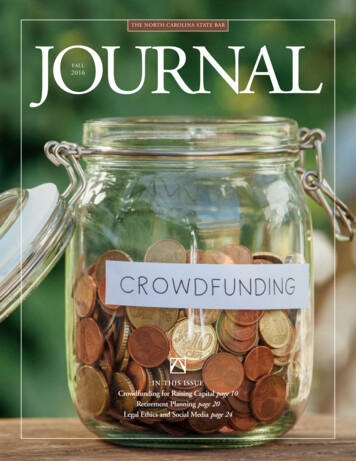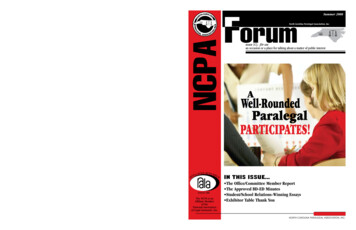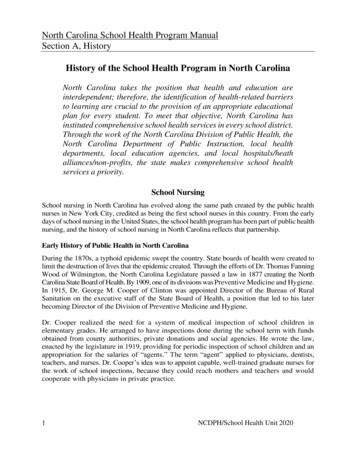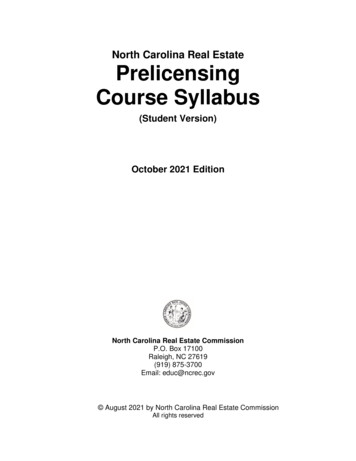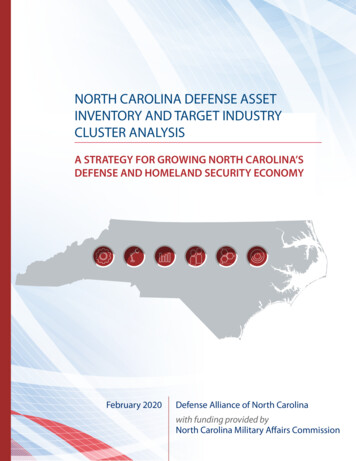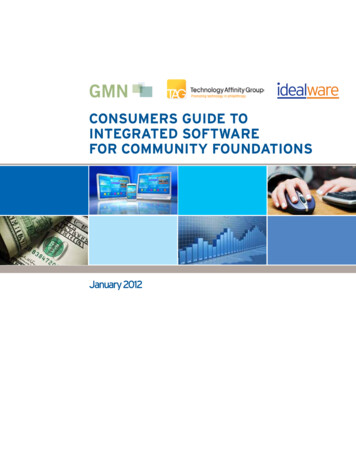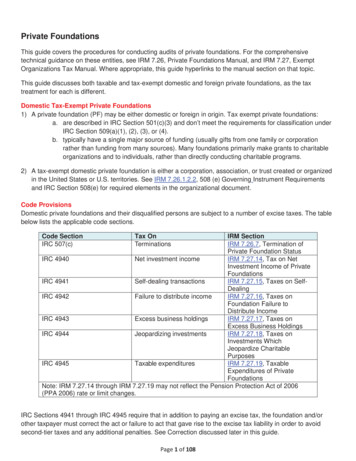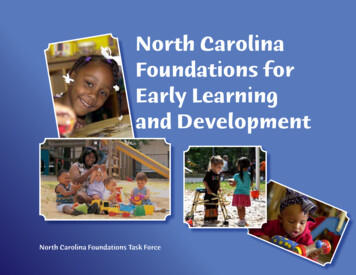
Transcription
North CarolinaFoundations forEarly Learningand DevelopmentNorth Carolina Foundations Task Force
North CarolinaFoundations forEarly Learningand DevelopmentNorth Carolina Foundations Task Force
The North Carolina Foundations for EarlyLearning and Development may be freelyreproduced without permission for non-profit,educational purposes.North Carolina Foundations forEarly Learning and Development 2013. North Carolina FoundationsTask Force.WritersDesignerCatherine Scott-LittleHuman Development and Family Studies DepartmentUNC-GreensboroGina HarrisonFrank Porter Graham Child Development InstituteUNC-Chapel HillGlyn BrownSERVE CenterUNC-GreensboroPhotographyEdna CollinsDivision of Child Development and Early EducationNC Department of Health and Human ServicesEditorsLindsey AlexanderLindsey Alexander EditorialKatie HumeFrank Porter Graham Child Development InstituteUNC-Chapel HilliiPages:60 and 143 courtesy ofUNC-Greensboro, Child Care Education Program.36, 54, 135, 136, front cover (group shot), andback cover (infant) courtesy ofNC Department of Health and Human Services,Division of Child Development and Early Education.All others:Don Trull, John CotterFrank Porter Graham Child Development InstituteUNC-Chapel HillNorth Carolina Foundations for Early Learning and DevelopmentElectronic versions of this report are availablefrom the following /www.ncpublicschools.org/earlylearningSuggested citation: North CarolinaFoundations Task Force. (2013). NorthCarolina foundations for early learning anddevelopment. Raleigh: Author.Funding for this document was provided bythe North Carolina Early Childhood AdvisoryCouncil using funds received from a federalState Advisory Council grant from theAdministration for Children and Families, U.S.Department of Health and Human Services.
Table of ContentsAcknowledgements . . . . . . . . . . . . . . . . . . . . . . . . . . . . . . . . . . . . . . vIntroduction . . . . . . . . . . . . . . . . . . . . . . . . . . . . . . . . . . . . . . . . . . . . . 1Purpose of Foundations. . . . . . . . . . . . . . . . . . . . . . . . . . . . . . . . . . . . . . . . . . . . . . . . . . . . . . . . . . . . . . . . . . . . 2Organization of This Document. . . . . . . . . . . . . . . . . . . . . . . . . . . . . . . . . . . . . . . . . . . . . . . . . . . . . . . . . . . . 3How to Use Foundations. . . . . . . . . . . . . . . . . . . . . . . . . . . . . . . . . . . . . . . . . . . . . . . . . . . . . . . . . . . . . . . . . . . 6Domains, Subdomains, and Goals Overview. . . . . . . . . . . . . . . . . . . . . . . . . . . . . . . . . . . . . . . . . . . . . . . . . . 8Guiding Principles. . . . . . . . . . . . . . . . . . . . . . . . . . . . . . . . . . . . . . . . . . . . . . . . . . . . . . . . . . . . . . . . . . . . . . . . 13Effective Use of Foundations with All Children. . . . . . . . . . . . . . . . . . . . . . . . . . . . . . . . . . . . . . . . . . . . . . . 15Foundations and Children’s Success in School. . . . . . . . . . . . . . . . . . . . . . . . . . . . . . . . . . . . . . . . . . . . . . . . . 17Helping Children Make Progress on Foundations Goals:It Takes Everyone Working Together . . . . . . . . . . . . . . . . . . . . . . . . . . . . . . . . . . . . . . . . . . . . . . . . . . . . . . . 20Frequently Asked Questions. . . . . . . . . . . . . . . . . . . . . . . . . . . . . . . . . . . . . . . . . . . . . . . . . . . . . . . . . . . . . . 22Approaches to Play and Learning (APL). . . . . . . . . . . . . . . . . . . 26Curiosity, Information-Seeking, and Eagerness . . . . . . . . . . . . . . . . . . . . . . . . . . . . . . . . . . . . . . . . . . . . . .Play and Imagination. . . . . . . . . . . . . . . . . . . . . . . . . . . . . . . . . . . . . . . . . . . . . . . . . . . . . . . . . . . . . . . . . . . . .Risk-Taking, Problem-Solving, and Flexibility. . . . . . . . . . . . . . . . . . . . . . . . . . . . . . . . . . . . . . . . . . . . . . . . .Attentiveness, Effort, and Persistence. . . . . . . . . . . . . . . . . . . . . . . . . . . . . . . . . . . . . . . . . . . . . . . . . . . . . .30343842Emotional and Social Development (ESD). . . . . . . . . . . . . . . . 48Developing a Sense of Self. . . . . . . . . . . . . . . . . . . . . . . . . . . . . . . . . . . . . . . . . . . . . . . . . . . . . . . . . . . . . . . . 52Developing a Sense of Self With Others . . . . . . . . . . . . . . . . . . . . . . . . . . . . . . . . . . . . . . . . . . . . . . . . . . . . 56Learning About Feelings. . . . . . . . . . . . . . . . . . . . . . . . . . . . . . . . . . . . . . . . . . . . . . . . . . . . . . . . . . . . . . . . . . 61iiiNorth Carolina Foundations for Early Learning and Development
Health and Physical Development (HPD). . . . . . . . . . . . . . . . . 66Physical Health and Growth. . . . . . . . . . . . . . . . . . . . . . . . . . . . . . . . . . . . . . . . . . . . . . . . . . . . . . . . . . . . . . .Motor Development. . . . . . . . . . . . . . . . . . . . . . . . . . . . . . . . . . . . . . . . . . . . . . . . . . . . . . . . . . . . . . . . . . . . .Self-Care. . . . . . . . . . . . . . . . . . . . . . . . . . . . . . . . . . . . . . . . . . . . . . . . . . . . . . . . . . . . . . . . . . . . . . . . . . . . . . .Safety Awareness . . . . . . . . . . . . . . . . . . . . . . . . . . . . . . . . . . . . . . . . . . . . . . . . . . . . . . . . . . . . . . . . . . . . . . .70758084Language Development and Communication (LDC) . . . . . . . 88Learning to Communicate. . . . . . . . . . . . . . . . . . . . . . . . . . . . . . . . . . . . . . . . . . . . . . . . . . . . . . . . . . . . . . . . 93Foundations for Reading . . . . . . . . . . . . . . . . . . . . . . . . . . . . . . . . . . . . . . . . . . . . . . . . . . . . . . . . . . . . . . . . 104Foundations for Writing. . . . . . . . . . . . . . . . . . . . . . . . . . . . . . . . . . . . . . . . . . . . . . . . . . . . . . . . . . . . . . . . . . 111Cognitive Development (CD). . . . . . . . . . . . . . . . . . . . . . . . . . . . 116Construction of Knowledge: Thinking and Reasoning. . . . . . . . . . . . . . . . . . . . . . . . . . . . . . . . . . . . . . . . . 121Creative Expression. . . . . . . . . . . . . . . . . . . . . . . . . . . . . . . . . . . . . . . . . . . . . . . . . . . . . . . . . . . . . . . . . . . . . . 127Social Connections. . . . . . . . . . . . . . . . . . . . . . . . . . . . . . . . . . . . . . . . . . . . . . . . . . . . . . . . . . . . . . . . . . . . . . 131Mathematical Thinking and Expression. . . . . . . . . . . . . . . . . . . . . . . . . . . . . . . . . . . . . . . . . . . . . . . . . . . . . 137Scientific Exploration and Knowledge . . . . . . . . . . . . . . . . . . . . . . . . . . . . . . . . . . . . . . . . . . . . . . . . . . . . . 144Supporting Dual Language Learners (DLL). . . . . . . . . . . . . . . 149Defining Dual Language Learners. . . . . . . . . . . . . . . . . . . . . . . . . . . . . . . . . . . . . . . . . . . . . . . . . . . . . . . . 149The Dual Language Learning Process. . . . . . . . . . . . . . . . . . . . . . . . . . . . . . . . . . . . . . . . . . . . . . . . . . . . . 149DLL and Culture. . . . . . . . . . . . . . . . . . . . . . . . . . . . . . . . . . . . . . . . . . . . . . . . . . . . . . . . . . . . . . . . . . . . . . . 150The Importance of Families. . . . . . . . . . . . . . . . . . . . . . . . . . . . . . . . . . . . . . . . . . . . . . . . . . . . . . . . . . . . . . 152DLL and Standards. . . . . . . . . . . . . . . . . . . . . . . . . . . . . . . . . . . . . . . . . . . . . . . . . . . . . . . . . . . . . . . . . . . . . . 153Conclusion. . . . . . . . . . . . . . . . . . . . . . . . . . . . . . . . . . . . . . . . . . . . . . . . . . . . . . . . . . . . . . . . . . . . . . . . . . . . 154Glossary . . . . . . . . . . . . . . . . . . . . . . . . . . . . . . . . . . . . . . . . . . . . . . . 155Selected Sources . . . . . . . . . . . . . . . . . . . . . . . . . . . . . . . . . . . . . . . 163ivNorth Carolina Foundations for Early Learning and Development
AcknowledgmentsIn 2011, the North Carolina Early ChildhoodAdvisory Council (ECAC) launched andfunded the important project of revisingthe Infant-Toddler Foundations andPreschool Foundations to create the NorthCarolina Foundations for Early Learning andDevelopment—a single document that describeschildren’s development and learning from birthto age five. Leaders from the Division of ChildDevelopment and Early Education as well asthe Office of Early Learning in the Departmentof Public Instruction provided critical advice,oversight, and vision on the Foundations and itsimplementation. As listed below, many individualsfrom across the state devoted their time andexpertise to this task force. We are grateful toeveryone’s work on this important resource forour state.This publication is dedicated to North Carolina’searly childhood professionals, teachers, andcaregivers who nurture and support thedevelopment of many young children while theirfamilies work or are in school.NC Foundations Task ForceExpert ReviewersInter-Agency Leadership TeamLaura BerkProfessor Emeritus, Psychology DepartmentIllinois State UniversityDivision of Child Development and Early EducationNC Department of Health and Human ServicesSharon GloverCultural Competence ConsultantGlover and AssociatesMelissa JohnsonPediatric PsychologistWakeMed Health and HospitalsPatsy PierceSpeech Language PathologistLegislative AnalystNC General Assembly Research DivisionDeb CassidyAnna CarterEdna CollinsJani KozlowskiLorie PughOffice of Early LearningNC Department of Public InstructionJohn PruetteJody KoonHuman Development and Family Studies DepartmentUNC-GreensboroCatherine Scott-Little, Co-FacilitatorSheresa Boone BlanchardFrank Porter Graham Child Development InstituteUNC-Chapel HillKelly Maxwell, Co-FacilitatorvNorth Carolina Foundations for Early Learning and Development
NC Foundations Task Force (cont.)Foundations Revisions ExpertWorkgroupNorm AllardPre-K Exceptional Children ConsultantOffice of Early LearningNC Department of Public InstructionJoe AppletonKindergarten TeacherSandy Ridge Elementary SchoolCindy BagwellCo-Chair of Cognitive Development WorkgroupEarly Childhood Education ConsultantOffice of Early LearningNC Department of Public InstructionHarriette BaileyAssistant ProfessorBirth-Kindergarten Program CoordinatorDepartment of Education, Shaw UniversitySheila BazemoreEducation ConsultantDivision of Child Development and Early EducationNC Department of Health and Human ServicesDeborah CarrollBranch HeadEarly Intervention, Division of Public HealthNC Department of Health and Human ServicesRonda HawkinsChair of Emotional and Social Development WorkgroupEarly Childhood Program CoordinatorSandhills Community CollegeKathryn ClarkProfessor, Child Development Program CoordinatorChild Development, Meredith CollegePatricia HearronChair of Approaches to Learning WorkgroupProfessor, Family and Consumer SciencesAppalachian State UniversityRenee CockrellPediatricianRocky Mount Children’s Developmental Services AgencyLanier DeGrellaInfant Toddler Enhancement Project ManagerChild Care Services AssociationSherry FranklinQuality Improvement Unit ManagerDivision of Public HealthNC Department of Health and Human ServicesKate GallagherChild Care Program DirectorFrank Porter Graham Child Development InstituteUNC-Chapel HillStaci Herman-DraussInfant Toddler Education SpecialistChild Care Services AssociationVivian James619 CoordinatorPre-K Exceptional Children, Office of Early LearningNorth Carolina Department of Public InstructionLaTonya KennedyTeacherMountain Area Child and Family CenterDoré LaForettInvestigatorFrank Porter Graham Child Development InstituteUNC-Chapel HillBonnie BeamDirectorOffice of School Readiness, Cleveland County SchoolsKhari GarvinDirector, Head Start State Collaboration OfficeOffice of Early LearningNC Department of Public InstructionGwen BrownRegulatory SupervisorDivision of Child Development and Early EducationNC Department of Health and Human ServicesCristina GillandersScientistFrank Porter Graham Child Development InstituteUNC-Chapel HillGerri MattsonPediatric Medical ConsultantDivision of Public HealthNC Department of Health and Human ServicesPaula CancroPreschool DirectorOur Lady of Mercy Catholic SchoolPamela HauserChild Care Licensing ConsultantDivision of Child Development and Early EducationNC Department of Health and Human ServicesJanet McGinnisEducation ConsultantDivision of Child Development and Early EducationNC Department of Health and Human ServicesviNorth Carolina Foundations for Early Learning and DevelopmentBeth LeiroPhysical TherapistBeth Leiro Pediatric Physical Therapy
NC Foundations Task Force (cont.)Margaret MobleyManager, Promoting Healthy Social Behavior inChild Care SettingsChild Care Resources, Inc.Brenda WilliamsonAssistant Professor, Birth-Kindergarten Teacher EducationProgram CoordinatorNC Central UniversityJudy NeimeyerProfessor EmeritaSpecialized Education ServicesUNC-GreensboroGale WilsonRegional SpecialistNC Partnership for ChildrenEva PhillipsInstructor, Birth-Kindergarten EducationWinston-Salem State UniversityJackie QuirkChair of Health and Physical Development WorkgroupProject CoordinatorNC Child Care Health and Safety Resource CenterUNC Gillings School of Global Public HealthAmy ScrinziCo-Chair of Cognitive Development WorkgroupEarly Mathematics ConsultantCurriculum and Instruction DivisionNC Department of Public InstructionJanet SingermanPresidentChild Care Resources, Inc.Diane StrangisAssistant ProfessorChild Development, Meredith CollegeDan TetreaultChair of Language and Communication WorkgroupK–2 English Language Arts ConsultantCurriculum and Instruction DivisionNC Department of Public InstructionCatherine WoodallEducation ConsultantDivision of Child Development and Early EducationNC Department of Health and Human ServicesDoyle WoodallPreschool TeacherJohnston County SchoolsDual Language Learners AdvisoryTeamCatherine Scott-Little, ChairAssociate Professor, Human Development and Family StudiesUNC-GreensboroTanya DennisTelamon CorporationShari FunkhouserPre-K Lead TeacherAsheboro City SchoolsCristina GillandersScientistFrank Porter Graham Child Development InstituteUNC-Chapel HillBelinda J. HardinAssociate Professor, Specialized Education ServicesUNC-GreensboroNorma A. HinderliterSpecial Education ExpertAdriana MartinezDirectorSpanish for Fun AcademyTasha Owens-GreenChild Care and Development Fund CoordinatorDivision of Child Development and Early EducationNC Department of Health and Human ServicesGexenia E. PardillaLatino Outreach SpecialistChild Care Resources Inc.Jeanne WakefieldExecutive DirectorThe University Child Care CenterStrategies WorkgroupSheresa Boone Blanchard, ChairChild Development and Family StudiesUNC-GreensboroPatsy BrownExceptional Children Preschool CoordinatorYadkin County SchoolsKristine EarlAssistant DirectorExceptional Children’s DepartmentIredell-Statesville SchoolsCristina GillandersScientistFrank Porter Graham Child Development InstituteUNC-Chapel HillWendy H-G GrayExceptional Children Preschool CoordinatorPitt County School SystemviiNorth Carolina Foundations for Early Learning and Development
NC Foundations Task Force (cont.)Patricia HearronProfessor, Family and Consumer SciencesAppalachian State UniversityStaci Herman-DraussInfant Toddler Education SpecialistChild Care Services AssociationTami HoltzmannPreschool CoordinatorThomasville City SchoolsSusan TraversExceptional Children Curriculum Manager andPreschool CoordinatorBuncombe County SchoolsRhonda WigginsExceptional Children Preschool CoordinatorWayne County Public SchoolsRenee JohnsonPreschool CoordinatorEdgecombe County Public SchoolJenny KurzerExceptional Children Preschool CoordinatorBurke County Public SchoolsBrenda LittlePreschool CoordinatorStokes County SchoolsKaren J. LongInfant Toddler SpecialistChild Care Resources, IncJackie QuirkProject CoordinatorNC Child Care Health and Safety Resource CenterUNC Gillings School of Global Public HealthBrenda SigmonPreschool CoordinatorCatawba County/Newton Conover Preschool ProgramTeresa SmithPreschool CoordinatorBeaufort County SchoolsviiiNorth Carolina Foundations for Early Learning and Development
IntroductionChildren’s experiences before theyenter school matter—researchshows that children who experiencehigh-quality care and education,and who enter school well prepared,are more successful in school and later intheir lives. Recognizing the importance of theearly childhood period, North Carolina hasbeen a national leader in the effort to providehigh-quality care and education for youngchildren. Programs and services such as SmartStart, NC Pre-K, early literacy initiatives, NurseFamily Partnerships and other home visitingprograms, and numerous other initiativespromote children’s learning and development.Quality improvement initiatives such as ourStar Rated License, Child Care Resource andReferral (CCR&R) agencies, T.E.A.C.H. EarlyChildhood Scholarship Project, and the ChildCare W.A.G.E.S. Project are designed to improvethe quality of programs and services and, in turn,benefit children. Although the approaches aredifferent, these programs and initiatives share asimilar goal—to promote better outcomes forNorth Carolina’s young children. This document,North Carolina Foundations for Early Learningand Development (referred to as Foundations),serves as a shared vision for what we want for ourstate’s children and answers the question “Whatshould we be helping children learn beforekindergarten?” By providing a common set ofGoals and Developmental Indicators for childrenfrom birth through kindergarten entry, ourhope is that parents, educators, administrators,and policy makers can together do the best jobpossible to provide experiences that help childrenbe well prepared for success in school and life.This Introduction provides importantinformation that adults need in order touse Foundations effectively. We discuss thepurpose of the document, how it should beused, and what’s included. We’ve also triedto answer questions that you might have, allin an effort to help readers understand anduse Foundations as a guide for what we wantchildren to learn during their earliest years.Foundationscan be used to: Improve teachers’ knowledge of childdevelopment; Guide teachers’ plans for implementingcurricula; Establish goals for children’sdevelopment and learning that areshared across programs and services;and Inform parents and other familymembers on age-appropriateexpectations for children’s developmentand learning.1North Carolina Foundations for Early Learning and Development
Purpose ofFoundationsA Note About TerminologyFoundations is designed to be usefulto a broad range of professionals whowork with children. In this document werefer to “teachers and caregivers.” Thisterminology includes anyone who workswith children—teachers, caregivers, earlyeducators, early interventionists, homevisitors, etc. The document also refers to“children” generically, which is intendedto include infants, toddlers, and preschoolchildren.2North Carolina’s Early Childhood AdvisoryCommittee, Division of Child Development andEarly Education, and Department of PublicInstruction Office of Early Learning workedtogether to develop Foundations to providea resource for all programs in the state.Foundations describes Goals for all children’sdevelopment and learning, no matter whatprogram they may be served in, what languagethey speak, what disabilities they may have,or what family circumstances they aregrowing up in. Teachers and caregivers canturn to Foundations to learn about childdevelopment because the document providesage-appropriate Goals and DevelopmentalIndicators for each age level—infant, toddler,and preschooler. Foundations is also intendedto be a guide for teaching–not a curriculumor checklist that is used to assess children’sdevelopment and learning, but a resourceto define the skills and abilities we wantto support in the learning experiences weprovide for children. The Goals for childrencan be used by teachers, caregivers, earlyinterventionists, home visitors, and otherprofessionals who support and promotechildren’s development and learning. It is,North Carolina Foundations for Early Learning and Developmenthowever, important to remember that whileFoundations can help you determine whatis “typical” for children in an age group, theDevelopmental Indicators may not alwaysdescribe a particular child’s development.When a child’s development and learningdoes not seem to fit what is included in thecontinuum under his/her age level, look at theDevelopmental Indicators for younger or olderage groups to see if they are a better fit for thechild. Your goal is to learn what developmentalsteps the child is taking now, and to meet theindividual needs of that child on a daily basis.Foundations can also be used as a resourcefor parents and other family members. Allparents wonder if their child is learning what’sneeded in order to be successful in school.Parents will find it helpful to review the Goalsand Developmental Indicators to learn whatmost early educators in North Carolina feel areappropriate goals for young children.Finally, Foundations is a useful documentfor individuals who do not work directlywith children, but who support teachersand caregivers in their work. It is importantto take stock to see if a program’s learningenvironment, teaching materials, learningactivities, and interactions are supportingchildren’s development in the areas described
in Foundations. Administrators can useFoundations as a guide to evaluate the typesof learning experiences provided in theirprogram. Foundations can also be a resourceto identify areas where teachers and caregiversneed to improve their practices and as abasis for professional development. Trainingand technical assistance providers shouldevaluate the support they provide to teachersand caregivers to ensure that the professionaldevelopment is consistent with the Goals andDevelopmental Indicators. Furthermore,Foundations can be used as a textbook inhigher education courses and a training manualfor in-service professional development. Insummary, Foundations is designed to be aresource for teachers, caregivers, parents,administrators, and professional developmentproviders as we work together to support thelearning and development of North Carolina’syoungest children.Organization ofThis DocumentThis document begins with this Introduction,which provides background informationon the use of Foundations. Following theIntroduction, you will find the Goals andDevelopmental Indicators, which describeexpectations for what children will learn priorto kindergarten, starting with infancy andcovering all ages through kindergarten entry.A glossary with definitions of key terms thatare used throughout Foundations is includedat the end of the document.The Goals and Developmental Indicators aredivided into five domains: Approaches to Play and Learning (APL) Emotional and Social Development (ESD) Health and Physical Development (HPD) Language Development andCommunication (LDC) Cognitive Development (CD)Because infants’, toddlers’, and preschoolchildren’s bodies, feelings, thinking skills,language, social skills, love of learning, andknowledge all develop together, it is essentialthat we include all five of these domains inFoundations. None of the domains is moreor less important than others, and there issome overlap between what is covered in onedomain and what’s covered in other domains.This is because children’s developmentand learning is integrated or interrelated.The progress that a child makes in onedomain is related to the progress he or shemakes in other domains. For example, asa child interacts with adults (i.e., SocialDevelopment), she/he learns new words(i.e., Language Development) that help her/him understand new concepts (i.e., CognitiveDevelopment). Therefore, it is essential thatFoundations address all five domains, andthat teachers and caregivers who are usingFoundations pay attention to all five domains.At the beginning of each domain section,you will find a domain introduction thatdescribes some of the most important ideasrelated to the domain. This introductoryinformation helps you understand whataspects of children’s learning and developmentare included in the domain. The introductionis followed by the Goal and DevelopmentalIndicator Continuum (sometimes called a“Continuum” for short in this document) foreach domain. The Continuum for each domainis a chart that shows the Goals for the domain,and the Developmental Indicators related toeach Goal for each age level. As the samplechart on the next page shows, North Carolinahas elected to arrange our DevelopmentalIndicators along a continuum so that all ofthe Developmental Indicators for the agelevels between birth and kindergarten entryare included on the same row. This formatallows teachers and caregivers to easily lookacross the age levels to see the progressionthat a child might make toward the Goal.3North Carolina Foundations for Early Learning and Development
The Goals are organized in subdomainsor subtopics that fall within the domain.Goals are statements that describe a generalarea or aspect of development that childrenSubdomaindefines areaswithin each domainmore specificallymake progress on through birth throughage five. The Developmental Indicatorsare more specific statements of expectationsfor children’s learning and developmentthat are tied to particular age levels. A Goaland Developmental Indicator Continuum isprovided for each Goal.Domainrefers to the broad area of learning ordevelopment that is being addressedApproaches to Play and Learning (APL)Curiosity, Information-Seeking, and EagernessGoalprovides a broad statement ofwhat children should know orbe able to doGoal APL-1: Children show curiosity and express interest in the world around them.Developmental IndicatorsInfantsYounger Toddlers Show interest in Imitate what others areothers (smile or gaze atdoing. APL-1dcaregiver, make sounds Show curiosity aboutor move body when othertheir surroundingsperson is near). APL-1a(with pointing, facial Show interest inexpressions, words).themselves (watch ownAPL-1ehands, play with own Show pleasure whenfeet). APL-1bexploring and making React to new sights,sounds, tastes, smells,and touches (stick outtongue at first solid food,turn head quickly whendoor slams).APL-1cOlder Toddlers Discover things thatinterest and amazethem, and seek toshare them withothers. APL-1g Show pleasure in newskills and in what theyhave done. APL-1h Watch what others arethings happen (clap, smile,doing and often try torepeat action again andparticipate. APL-1iagain). APL-1fOlder Preschoolers Discover things thatinterest and amaze them,and seek to share themwith others. APL-1m Communicate interestto others through verbaland nonverbal means(take teacher to thescience center to see anew animal). APL-1k Communicate interest toothers through verbal andnonverbal means (taketeacher to the sciencecenter to see a newanimal). APL-1n Show interest in a growingrange of topics, ideas,and tasks. APL-1l Show interest ina growing range oftopics, ideas, and tasks.APL-1o Demonstrate interest inmastering new skills (e.g.,writing name, riding a bike,dance moves, buildingskills). APL-1pDevelopmental Indicatorprovides more specific informationabout what children should know or beable to do at4Younger Preschoolers Discover things thatinterest and amazethem, and seek to sharethem with others. APL-1j28North Carolina Foundations for Early Learning an
Foundations Task Force. (2013). North Carolina foundations for early learning and development. Raleigh: Author. Funding for this document was provided by the North Carolina Early Childhood Advisory Council using funds received from a federal State Advisory Council grant from the Administration for Children and Families, U.S.
